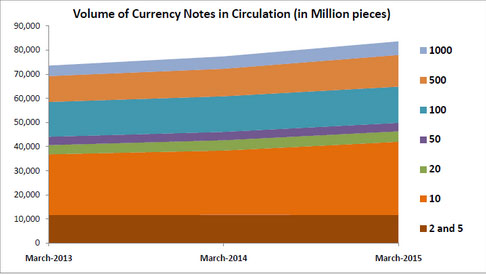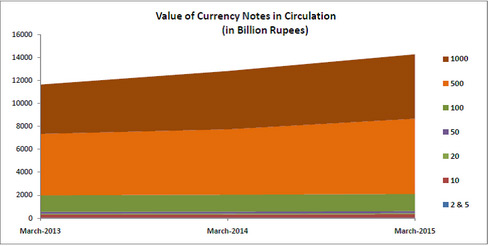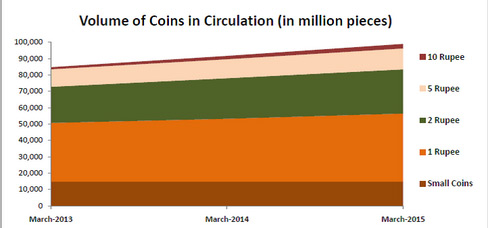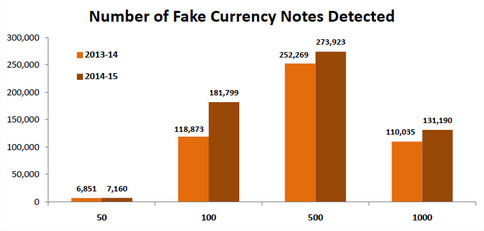
The Reserve Bank of India (RBI) publishes an annual report every year.
One of the chapters in this Annual Report is on Currency Management. This chapter deals with the trends in demand for banknotes of various denomination, currency management infrastructure and trends in counterfeit notes among other things.
Proportion of 10, 500 & 1000 rupee notes in total volume rising
Despite card transactions growing by over 10% each year, the demand for currency notes hasn't come down.
The number of currency notes in circulation has increased for all the denominations except 2 & 5 rupees.
There are variations in growth of different denominations leading to an increasing proportion of 10, 500 and 1000 rupee notes in the total volume of bank notes in circulation.
The data with the RBI indicates that the proportion of 10, 500 & 1000 rupee notes in total volume of banknotes in circulation is rising each year from 2013 to 2015.
The number of 2 & 5 rupee notes in circulation is more or less constant through the years 2013 to 2015.
There is a steep increase in the number of 10 rupee notes in circulation in 2015. From around 25000 million notes in 2013, the 10 rupee notes in circulation went up to more than 30000 million in 2015.
While there is a marginal rise in the number of 20, 50 and 100 rupee notes in circulation from 2013 to 2015, their proportion in the total volume has gone down in these three years.
There is a steady rise in the number of 500 rupee and 1000 rupee notes in circulation. The proportion of 500 rupee notes in the total volume went up from 14.7% in 2014 to 15.7% in 2015.

500 & 1000 rupee notes contribute to 85% Value of all the notes in circulation
Because of their higher value, the 500 & 1000 rupee notes contribute to 85% of the value of all the notes in circulation.
Except for these two denominations, the proportion of contribution of all the other denominations has come down from 2013 to 2015.
While the contribution of 2 & 5 rupee notes is nominal at around 0.3%, the contribution of 10 rupee notes is around 2.1%.
This is particularly interesting since the number of 10 rupee notes has gone up substantially in 2015.
Despite the increase, the contribution has not gone up because of the lower denomination. The contribution of 500 rupee notes is close to 46% and the contribution of 1000 rupee notes is close to 40%.

What about Coins?
Despite the increase in the use of plastic currency & high value denomination currency like 500 & 100 rupee notes, the demand for coins of lower denomination has also increased continuously from 2013 to 2015. While there has been no increase in the number of small coins, there has been steady increase in the number of 1 rupee and 2 rupee coins.
Even the 5 rupee & 10 rupee coins have seen a marginal increase in these 3 years. Both 1 rupee & 2 rupee coins account for close to 50% of the total value, while the 5 rupee & 10 rupee coins account for about 47% of the total value.

The Menace of Fake Notes
During 2014-15, a total of 5,94,446 pieces of fake notes were detected in the banking system compared to 4,88,273 fake notes in 2013-14.
The number of fake notes increased in 2014-15 for all denominations except 2 & 5 rupees.
While the number of fake notes seems to be increasing, their percentage compared to the notes in circulation is negligible.
The percentage of fake 500 rupee & 1000 rupee notes is about 0.002%, the percentage of fake 100 rupee notes is about 0.001%. The percentage of all fake notes in 2014-15 is about 0.0007%.

To deal with the menace of fake notes, the RBI has initiated steps like withdrawal of the pre-2005 series of bank notes.
In accordance with the international practice of not having multiple series of banknotes simultaneously in circulation, the process of withdrawal of pre-2005 series of banknotes, in phases, was initiated in 2014.
The RBI has extended the date of withdrawal to December 31st, 2015 to ensure least inconvenience to public.
(Rakesh has been working on issues related to Right to Information (RTI) for a decade. He is a Data/Information enthusiast & passionate about Governance/Policy issues).



















